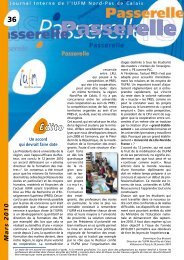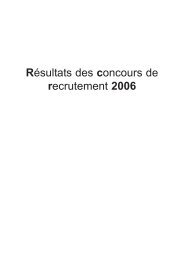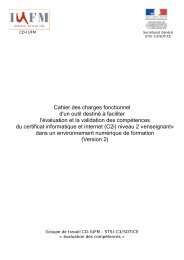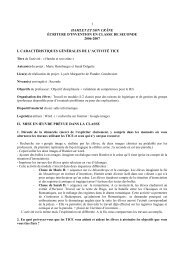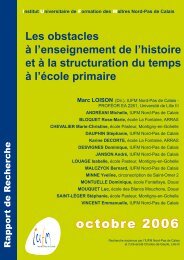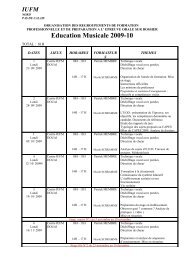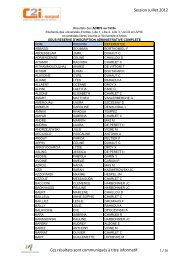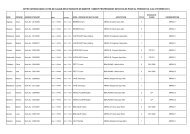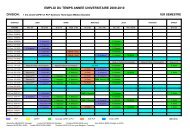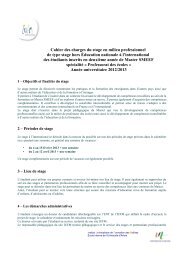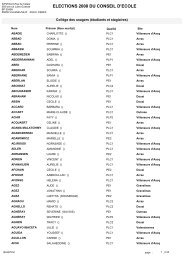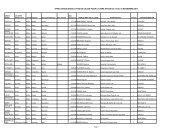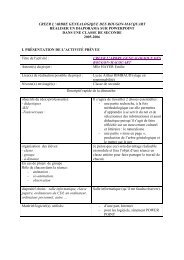You also want an ePaper? Increase the reach of your titles
YUMPU automatically turns print PDFs into web optimized ePapers that Google loves.
However, this characteristic is not as frequent in geometrics construction exercises of the<br />
e<strong>le</strong>mentary school schoolbooks. On the other hand, it is frequent in the “description of<br />
recipes” schoolbooks;<br />
At this <strong>le</strong>vel, this genre, as those of "construction programs” or “users books” take up a<br />
rather important part in school activities, and can be found in places other than schools.<br />
Lastly, the discursive ways using “I” with which a pupil shows the reader what he can do or<br />
manages to do is a characteristic of school evaluation situations.<br />
Therefore, S.I.A. interpretation of results appears to take into account univocal links. On the<br />
opposite of traditional analysis links can be interpreted as constraining ru<strong>le</strong>s governing over<br />
the actions observed.<br />
3. Regulations relative to groups of subjects, ru<strong>le</strong>s established on<br />
observab<strong>le</strong> modalities and on contributory variab<strong>le</strong>s modalities.<br />
An important prob<strong>le</strong>matic in mathematics didactics is, as we have exposed it earlier, that<br />
of the interpretation of regulations in pupils actions seen in groups characteristics. It is a<br />
matter of trying to know if we can give the status of “results of teaching devices used” to<br />
certain behaviours and to certain skills. These issues are what trigger experiments as well<br />
as comparisons of ordinary school practical experiences. It is about sorting what is specific<br />
to a group of pupils, whichever methodology is used : in the case of experiments, we are<br />
trying to compare the performance or competence of pilot groups and those of experimental<br />
groups, in the case of observations, the groups constituted are all classes.<br />
The study mentioned above registers in these issues exposed, since it questions some<br />
teachers demand to set up specific teaching devices in their classes. The study attempts<br />
to describe the effects of such a way of functioning, from the pupils’ performance point.<br />
Its goal is to show the results strengthening or invalidating the hypothesis according to<br />
which, particular effects, read in pupils’ behaviours, can be linked to specific devices used<br />
in classes. It is the question that takes us to compare the readings done by the scientist in<br />
charge of pupils group activities, according to them having being granted such teaching<br />
ways or not. Remember that there are seven classes studied. They are e<strong>le</strong>mentary classes<br />
respectively 9 years old and 10 years old, all located in the suburbs of Lil<strong>le</strong>.<br />
Taking up again the different characteristics studied, relative to geometrics and linguistics<br />
skills, we are now studying links connecting the different items showing to what class they<br />
belong.<br />
This graph has been comp<strong>le</strong>ted keeping only the paths <strong>le</strong>ading or getting to one of the<br />
explored “classes”: the different CM1 (9 years old) or CM2 (10 years old) classes. We are<br />
thus trying to bring forth characteristics in groups of pupils.<br />
3.1. "Isolated” groups<br />
Methodologically, we can first stop on the isolated groups. In the case of examp<strong>le</strong> we are<br />
elaborating upon, one of the CM2 class (“CM2WA”) is isolated. As it would be the case in<br />
“classical” analysis, the absence of implicative links marking this group of pupils is interpreted<br />
as a sign of diversity in this group of pupils’ written productions (according to the chosen<br />
<strong>IUFM</strong> Nord-Pas de Calais<br />
115




